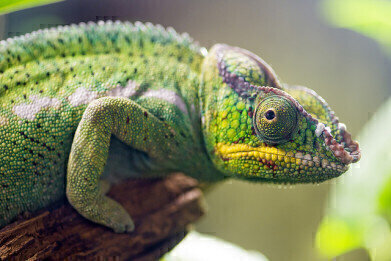News & Views
Which Is Faster, a Chameleons Tongue or a Space Shuttle Launch?
Feb 02 2016
Put a rocket ship and a lizard face to face and most people would think that the reptile would be seriously outclassed. Turns out, the smallest chameleon of them all can outperform even the fastest of launching space shuttles, with peak acceleration of 264 times the force of gravity. To put this figure into perspective, that’s the equivalent of getting from 0 to 60mph in a hundredth of a second. While it’s not quite on par with the force of a speeding bullet, scientists have proven that the tongue flicking speed of Rhampholeon spinosus is faster than the take-off speeds of NASA space shuttles!
Chameleon come up trumps
Brown University’s Christopher Anderson fronted the study, using 20 different chameleon species as part of the project. Rhampholeon spinosus was crowned the winner, despite the fact that it’s one of the world’s smallest chameleons, measuring in at just 47mm in length. Amazingly, the lizard is able to stick out its tongue to 2.5 times the length of its body, with a peak acceleration speed of 486 metres per second squared. Of all the reptiles, birds and mammals on the planet, this remarkable momentum gives it the highest measured acceleration and power output per kilogram of muscle mass.
In an incredible feat for the world’s ‘little critters’ Anderson found that the smaller the chameleon, the greater its tongue extension relative to body size, and the higher its relative power. Subsequently, the peak acceleration of Furcifer oustaletti (a species that’s two feet long than Rhampholeon spinosus) was just 18% of its smaller counterpart.
“Smaller species have higher performance than larger species,” explains Anderson, who recently revealed his findings in the Scientific Reports journal.
Big things come in small packages
So how does it work? Anderson asserts that the secret to supercharged tongue flicking in all down to how the power is stored. Despite being smaller than a human thumb, Rhampholeon spinosus preloads most of its energy into the tongue’s elastic tissue. Similar to how a crossbow user would crank up the tension before releasing for maximum impact.
For the scientific world, Anderson’s discoveries represent an opportunity to explore the theory that in order to stay alive, small creatures with big physiological powers must consume more energy per bodyweight.
“What this study shows is that by using smaller species, we may be able to elucidate these higher performance values,” says Anderson.
When it comes to power, size clearly doesn’t matter. For more insight into the incredible creatures that walk our earth, ‘Little Things that Run the World’ is a must read article.
Image via Flickr Creative Commons. Photo credits: Tambako the Jaguar
Digital Edition
Lab Asia 31.2 April 2024
April 2024
In This Edition Chromatography Articles - Approaches to troubleshooting an SPE method for the analysis of oligonucleotides (pt i) - High-precision liquid flow processes demand full fluidic c...
View all digital editions
Events
Apr 22 2024 Marrakech, Morroco
Making Pharmaceuticals Exhibition & Conference
Apr 23 2024 Coventry, UK
Apr 23 2024 Kintex, South Korea
Apr 23 2024 Seoul, South Korea
Apr 24 2024 Jakarta, Indonesia








.jpg)









